#and what was is that box was a very shiny colorful tron
Explore tagged Tumblr posts
Text

so i just got this super cool tron figure that i didnt knew existed and its now my favorite thing i own :D
#EKKOdraws#my art#so for the last month i had been with a huge urge to get a new transformer for the collection and i was looking for where i could get one#and in the search for it i came across this like inmense toy store that had those cool 2000s toys#and there i was in the transformers ille going throuh some TFDOTM stuff with my aunt and she wanders off for a moment#so i start looking for her and i find her in the hot toys part talking with a guy from the store explaning her about the brands and stuff#so i start cheking what she is seeing and theres the avengers and terminator and jeff bridges#JEFF BRIDGES???!!!#and there he was a life like replica of jeff as kevin flynn and im like really happy to se some TRON#and then i look to the side and my heart literaly stopped like i really had to double check that what i was seeing was real#there was a whole shelf of tron stuff like the dimond selects and the legacy bikes and guards and quorra and im so so happy#like OMG WHAT AM I GOING TO BUY NOW??? i was going to get the dimond select tron but then i realized there was a VHS case#and im like what#whats a VHS doing here so i asked the guy and he said it was some kind of exclusive but he didnt knew which one#so im like yeah im getting whatever is in that box#and what was is that box was a very shiny colorful tron#so im happy#and i did get the new transformer#sorry i had to write it somewhere im really happy#tron#tron uprising#tron legacy#tron 1982#tronblr#yori fanart
71 notes
·
View notes
Text
How to Actually Play Magic: The Gathering
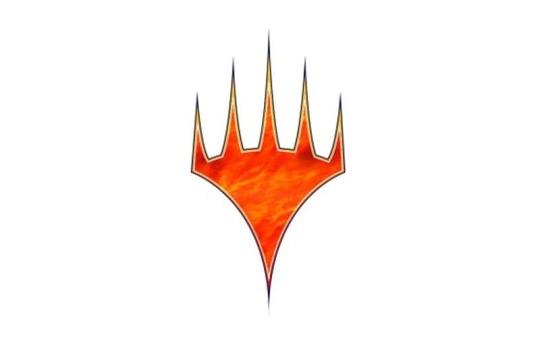
Magic: The Gathering (MTG, or just Magic) is the first and one of the most popular trading card games in the world. Described as the chess of card games, you can go as complex as you want (even make a computer) or have as much fun as you want, diving into the multitudes of worlds, creatures, and characters to express yourself.
But first you need to know how to play.
Lots of guides tend to be overly simplistic, so here I’ll try to go really in-depth in the rules while still maintaining an introductory tone. I will also try to provide as many pictures of relevant cards as possible to expose you to the vast array of effects cards may have, and how they interact with what I’m currently discussing.
1. The Colors of Magic

The most defining part of Magic are the five different colors. Each has its own flavor, playstyle, advantages, and disadvantages. You can combine different colors in your deck to have access to interesting combos and to balance out your deck’s weaknesses. Different color combinations also have their own specific flavor, often embodied by groups such as the guilds of Ravnica.
White: This is the color of unity, healing, and order. Cards in this color will often gain you life, protect your creatures from damage, tax or outright prevent your opponents from doing tricky things, and make armies of small creatures that together make mighty fighting forces. It is also associated with artifacts, enchantments, and exiling.
By the way, I will be defining Magic terms as they come up, like so.
Token: A representation of a creature, artifact, or something else. You can use it like a card while it exists, but it will vanish when it leaves the battlefield. (the rest of these terms will come up soon.)
Exile: Originally called “removed from the game”, exile is a zone that is inaccessible to most cards. It makes sure your opponents’ creatures go away forever. Sometimes, creatures go to exile and come right back to get extra enter-the-battlefield effects, known as blinking.
If you see something that isn’t immediately defined, just keep it in mind. Chances are I’ll cover it in a later chapter.
Blue: This color is related to knowledge, water, and the cold. You’ll get to draw lots of cards, but your creatures will be lacking. Instead, you will have access to powerful spells that bounce, freeze, or steal your opponents’ creatures and even give you extra turns. Quelch your opponents’ attempts with counterspells. It also has affinity for artifacts.
Black: This color represents death, disease, and ambition. Full of evil kill and discard spells, you will have access to your own army of zombies, vampires, and demons. You will also be able to do powerful things, but often at the cost of cards, creatures, or even your own health. In the words of Dark Confidant, “Greatness, at any cost.”
Red: This is the color of passion, fire, and explosive power. Many of the direct damage spells, including the iconic Lightning Bolt, are Red, as well as aggressive, fast creatures and multiple combats. You will have an extreme upper hand in your first few turns, but will quickly run out of gas if you don’t use another color to keep up on card draw. Red also brings with it mighty dragons and world-morphing chaotic effects.
Green: The color of nature, Green is similar to white in its abilities to heal, create tokens, and destroy artifacts and enchantments. However, Green has a wild side and is full of giant beasts, swarms of bugs, and rapid evolutions. It also brings out lands quickly and makes tons of mana.
2. Dissecting a Card

Sidisi is a popular character that hales from the plane of Tarkir. She’ll be helping us as a prime example of what a card looks like. There’s a lot to take in, but we’ll start from the top and work our way down.
First is the border (yes, from the very top!). It seems silly, but there are actually a few different borders that mean different things. A vast majority of cards have the regular black border. You may also see cards with white borders - these tend to be older cards, but they’re just as good as the black bordered ones. Silver borders come from the Un-sets, a series of joke sets full of wacky mechanics and inside jokes. None of these cards are tournament legal, but you’re free to have fun with them with your friends. Gold-bordered cards will also have a different back, and were printed as a part of tournament-winning decks back in the day. These are not tournament legal, but since they are often cheaper than their “real card” counterparts, people will use them in casual decks.

Next is the name. “Sidisi, Brood Tyrant” is the full, English name of this card. Each deck can only have up to 4 copies of any single card (there are very important exceptions to this I will cover in the next chapter). There are also a few cards which specifically reference others by name.
To the right of that is the mana cost. In this case, we need to use one black mana, one green mana, one blue mana (each represented by their respective symbol) and one mana which can be of any color, or even colorless, represented by the 1 in the circle. We’ll find out how to get mana in the next chapter as well. As a side note, many cards will consider the mana value (formerly, converted mana cost), which is just the total cost of the card as a number. For Sidisi, it’s four.
Beneath that is the art.

Arguably the most important part of any card, Magic’s art is what really sets it apart from other games. People fall in love with specific cards for their dramatic poses, mighty beings, and stunning vistas. The art brings character to every card, and ties flavor and function beautifully. This is the best way to express yourself, and find what you really like about Magic.

Next is a thin bar called the typeline. This will tell you first what type of card it is - either a land, creature, artifact, enchantment, planeswalker, instant, sorcery, or tribal (or some combination!), which dictate how you use the card, and what other cards interact with it. Card types can be divided into permanent, which go on the battlefield once played, and nonpermanent, which you play for a single effect and immediately go to your graveyard. There are also some supertypes. Sidisi herself is Legendary, meaning she represents a specific character from Magic lore. This also means you can only have a single copy of her on the battlefield at any one moment; if you somehow get another, you’ll have to sacrifice one. Basic is another important supertype we’ll cover soon.
On the other side of the hyphen is the subtype - this is almost exclusively used for creatures to tell you what tribes they belong to. Sidisi herself is a Naga and a Shaman, and will thus interact with cards that care about that (these are often called tribal effects; for example, “Elves you control get +1/+1″). From Trilobites to Trolls, the creatures of magic are a diverse crowd.
Finally comes the set symbol, that strange orange shield thingy to the right. This tells you two things: the set the card comes from, and the rarity. This specific symbol represents the set Khans of Tarkir, so booster packs from that set may contain Sidisi. Rarity comes in 5 different colors.

Black: Common (Simple, often weak)
Silver: Uncommon (May have cool mechanics)
Gold: Rare (More powerful and complex)
Orange: Mythic Rare (The most powerful and complex)
Purple: Special (This is only used in situations such as Time Spiral, where they reprinted cards in the old border)
The rarity often (but not necessarily) corresponds to power level. It’s better to think of it as a ranking of design complexity. Newer Rares and Mythics will also have that shiny, elliptical sticker near the bottom, which simply guarantees the authenticity of the card.

The bottom half of the card is dominated by the text box. This will tell you the effects and abilities of the card. Sidisi has two abilities: one that triggers whenever she enters the battlefield or attacks, and one that triggers whenever a creature card is put into the graveyard from your library (on modern cards, this is called milling). We will go over abilities later.
Notice how Sidisi aligns with her colors. As a Naga, she is Green. Her zombie tokens are characteristic of Black, and tokens are generally Green as well. Milling is a Blue ability, and putting creatures in the graveyard to bring back to life is definitely Black.
The text box is also home to flavor text, the italicized text beneath the rules. This will often be a little blurb or quote relating to the flavor of the card. Consider it an extension of the art.
Creatures will also have that rectangle to the bottom right, called the Power and Toughness. The first number is the power (how hard it punches) and the second is the toughness (how hard of a punch it can take). This is relevant for combat and we will cover it extensively later.
Finally come all those funny symbols at the very bottom. This will include the collector’s number (199/269), the set (KTK = Khans of Tarkir), the artist (Karl Kopinski) and the copyright.
3. Lands
Lands are by far the most important component of your deck. They are what generate the mana you need to cast your spells, and dictate the colors of spells you can play.
You can play one land per turn - just plop it from your hand onto the battlefield. They have no mana cost, and thus the top right is blank.
The Basic land is the prime exception to the four-card limit, as you can have as many as you want in your deck. The Basic supertype also interacts with several cards, such as ones which let you get more from your deck onto the battlefield.
The 6 basic lands are Plains (white), Island (blue), Swamp (black), Mountain (red), Forest (green), and Wastes (colorless, only used in decks such as Eldrazi Tron, and are often not included).

This cycle comes from Lorwyn, a set based in Gaelic mythology.
All Basic lands come with the implied rules text that they can tap to create one mana of their respective color, and as such will often have the cinematic mana symbol instead.
Tap: A common cost on a permanent to activate an ability. Turn the card sideways to tap it. It will stay tapped until your next turn, when it will untap during your untap phase (more on that later). A tapped card can’t be tapped again, and a tapped creature can’t block.
Some lands, especially those that can make different colors, will enter the battlefield tapped, so you’ll have to wait an extra turn to use them. Other lands might only create colorless mana (represented by a number on older cards and a diamond on newer cards), so they’re less useful for casting spells, but will have interesting abilities, such as:

This Mutavault can turn into a creature for just 1 mana, which you can use to attack and block with. (Pop quiz: see if you can recognize each part of the card!) There are dozens more examples that do everything from draw you cards to destroy your opponents’ pesky lands.
But what exactly does it mean to create a mana? Well, really, it gets added to your mana pool, as you may have noticed on the Mutavault. This is an arbitrary place where all your mana goes so that you can spend it. This isn’t often relevant, because you’ll mostly tap your lands while casting spells and the mana will immediately be used, but there are a few scenarios where it might be useful. For example, someone targets your land to destroy it because they don’t want you to have the mana open to kill something they’ll play next. Just tap your land to keep a mana “floating”. However, all the mana in your pool will automatically drain out each time you change phases (more on those later).
Tapping lands for mana is an ability, but since it’s a mana ability, it won’t use the stack, so you can use them just about whenever. More on the stack later as well.
Most decks will be around one-third lands, with more or less depending on how low the average cost of cards you have are. The less colors you run, the less cards you have at your disposal, but the more flexible your mana base can be - more colors often use lands that enter tapped and are inconsistent at drawing the colors they need.
Have fun experimenting with your mana base, especially in casual formats. In more competitive formats, lands are actually the most expensive cards! The top lands are called the shocklands, fetchlands, and original dual lands - the last of which are several hundred dollars each.
4. Permanents
Besides lands, just about every other card you play is considered a spell when you cast it (you’ll see this on cards such as Counterspell). However, for the sake of clarity, I’ll be using “Permanent” to refer to anything that goes directly on the battlefield once it resolves and “Spell” to refer to single-use cards.
Of the card types mentioned above, permanents include lands (which we just covered), creatures, artifacts, enchantments, and the mighty planeswalkers. I’ll include a visual example of each as we go.
Creatures are your basic way of winning the game. They can attack your opponent to take down their life total, but might also have interesting abilities that make them more valuable as repeatable spells than combatants.

Incubation druid is a great example of both: she starts off as an additional land, giving you more mana quicker to play your other cards. With 0 power, she’s useless as an attacker. However, her Adapt ability lets her grow into a formidable 3/5, so you can attack and block with her much more effectively later in the game. Notice the curved arrow symbol that represents tapping.
+1/+1 Counter: This is a permanent buff to your creature, giving it an additional power and toughness each. Counters in general can come in many forms: -1/-1 counters are self-explanatory, but ability counters such as a Flying counter give your creature a new keyword. Other counters, such as Lore and Filibuster, keep track of certain things for you. Always bring a few dice with you to every game, as you’re sure to want to track some sort of counter.
Creatures enter the battlefield with summoning sickness, which means they can’t attack or use any ability that requires them to tap until your next turn. Creatures also get summoning sick when they change control. A creature with Haste, a keyword ability, lets you ignore this, and is often found on red creatures.
Artifacts, lore wise, are artificial, sterile creations of wizardry, and as such, almost never correspond to a color. They may imitate the effects of a certain color, but to prevent other colors from having easy access to it, they will often be overcosted. A common type of artifact is colloquially known as the mana rock, as it generates mana. There are many cards that interact and enhance artifacts.

Hedron Archive is a typical mana rock, costing four mana of any color and boosting your mana generation ability by two. Later in the game, if you already have more than enough lands, you can cash it in for two mana to draw some more cards. Notice the distinct metallic border.
Artifacts often combine with Creatures to form Artifact Creatures, or less commonly with Lands to create Artifact Lands.
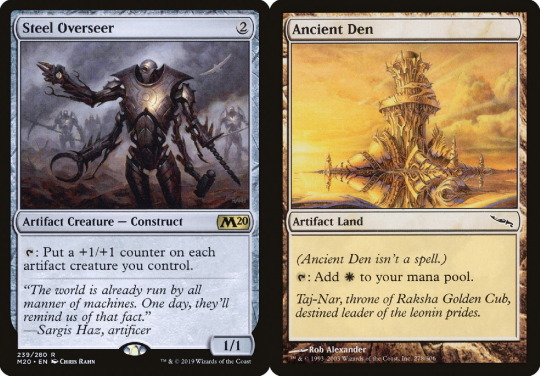
Artifacts can also come on the form of Equipment, which will give an effect when equipped to a creature. This often comes in the form of a buff to its power and toughness, but can also include adding keywords and other cool abilities. You’ll need to equip it by paying a cost, and can pass equipment around between any of your creatures. This can result in some funny mental images, such as a cat wearing a suit of armor and wielding three swords!

Enchantments are similar to artifacts in that they sit on the battlefield and have an effect, but they will have color. Also, Green and White excel at “cleansing” both by destroying them, but Red is only good at blowing up artifacts - after all, an ogre with a mace can smash a rock, but not a mystical spell.
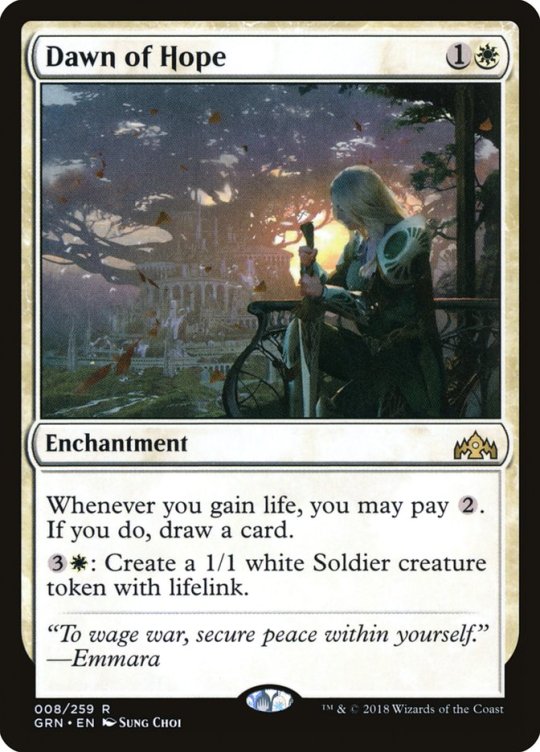
Some enchantments have the subtype Aura. This means you cast them targeting a specific permanent, and they will enter the battlefield attached to that permanent like a piece of Equipment. These, however, can’t be moved around, and will fall off and go to the graveyard if the thing they enchant ever leaves the battlefield. Auras will often buff creatures, but can also subdue permanents or boost a land’s mana production.

Planeswalkers are the newest and arguably the most powerful of the permanents. They represent the primary characters of MTG lore, beings who have incredible magical prowess and can teleport from plane to plane. They are (as of yet) all legendary, and thus you can only have one of each at a time on the battlefield.
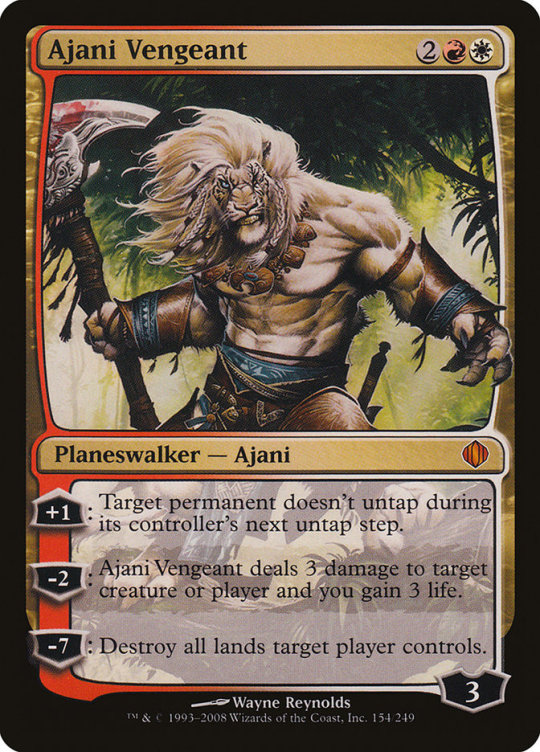
They look pretty weird, don’t they? Instead of a power and toughness, they have a loyalty in the bottom right. Each planeswalker will enter the battlefield with that many loyalty counters on it. You can activate one of its abilities on each of your turns by adding or subtracting the indicated loyalty. Once a planeswalker is at zero, it dies and goes to the graveyard (or rather, gets fed up with your mishandling and teleports away, as per loyalty flavor). Planeswalkers can also be killed by spells that specifically target them, when they’re dealt damage, or when they’re attacked by creatures. Their last ability is often incredibly powerful, and is called an “ultimate”. Newer planeswalkers sometimes also have static abilities.
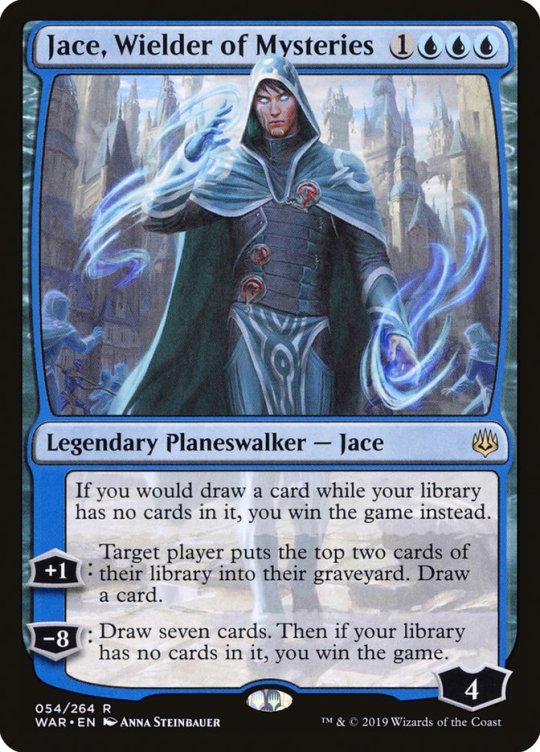
Planeswalkers are not creatures, and can’t attack or block. That being said, there are some planeswalkers that can turn into creatures.
Permanents are very useful, as they stick around and provide value turn after turn. Many strategies revolve around certain tribes, or using artifacts. Creatures are the main way to get damage through to your opponent to win the game. And planeswalkers have powerful abilities, requiring an answer from your opponent to stay in the game.
5. Spells
As stated above, all nonland cards are technically spells when cast, but here we will talk specifically about Instants and Sorceries. We will also define timing, as instant- and sorcery- speed is something we will discuss often when looking at casting spells, activating abilities, and using the stack.
Sorceries are your basic single-use card. Pay their cost, they’ll resolve, and you’ll get their effect once before they go to the graveyard.

Something I haven’t brought up yet is when you can play cards. We’ll go over the turn structure more in depth, but for now, know there’s a beginning step, a main phase, a combat phase, and a second main phase. You can play any of the previously mentioned cards, including sorceries, and activate planeswalker abilities, whenever it’s your main phase and the stack is empty.
The Stack: Whenever you cast a spell or activate a non-mana ability, or a triggered ability triggers, it will go on the stack. Things on the stack resolve last-in, first-out.
Instants are just like sorceries, but you can cast them at any time you have priority. This means they can go on the stack above other spells, which allows them to interact with other spells. Activated abilities can also be activated whenever, except for planeswalker abilities and those which specify otherwise.
Priority: When you have priority, you will have an opportunity to cast spells, play lands, and activate abilities. Everyone gets priority every phase, and it starts with the active player (whoever’s turn it is) and is passed around in turn order.
Whenever something goes on the stack, priority is passed around as well. Once each player has passed priority, it resolves and priority is passed once again for the next thing.
You can hold priority to cast multiple spells in a row.
Here’s a quick example to see how spells, abilities, and priority all interact on the stack:
Johnny and Timmy are playing each other, and it’s Timmy’s main phase. Johnny has a 0/2 Incubation Druid.
Timmy plays a Bala Ged Scorpion, which goes on the stack. Priority is passed around and it resolves. Its triggered ability goes on the stack, and Timmy targets Johnny’s Incubation Druid, since its power is 0, less than 1.
Since the ability is on the stack, Timmy gets priority and passes it to Johnny. In response, Johnny casts Burst of Strength, maintains priority, and casts a second Burst of Strength. Now priority passes between them for both, and they both resolve. Incubation Druid is now a 2/4.
Priority passes for Bala Ged Scorpion’s ability, but since the Incubation Druid now has more than 1 power, the ability does nothing and fizzles.
Fizzle: A spell whose target is no longer legal does nothing when it resolves. This is colloquially called fizzling.
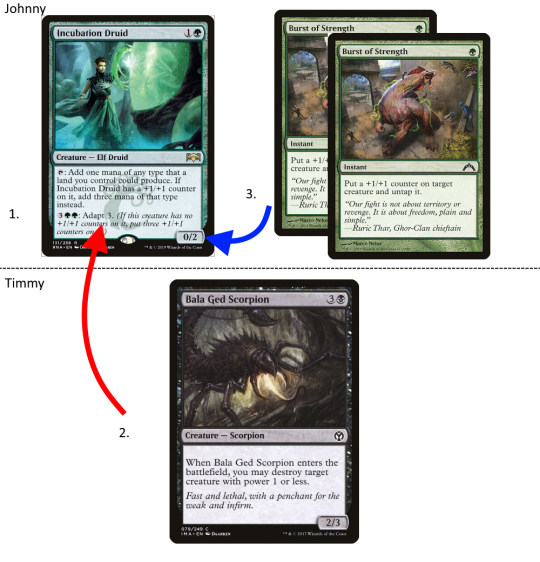
Assuming he had the mana for it, Johnny could also have activated Incubation Druid’s Adapt ability in response to the Bala Ged Scorpion, making it a 3/5 and also letting it survive.
There are lots of cool things you can do with the stack, such as making slick plays to foil your opponents’ spells or to copy big spells for massive value.
Some permanent cards have Flash. This is a keyword ability that lets you play the card as if it was an instant. Teferi, Mage of Zhalfir is the quintessential Flash card, as it also gives your other creatures flash and prevents your opponents from playing at instant speed.

6. Where are We?
I’ve been throwing around terms such as Graveyard and Battlefield, so what exactly do these mean? Well, these are all zones. We’ve already looked at one zone - Exile. The Stack is also a zone.
A zone is a place where cards can exist. They may have abilities that work while in that zone, most often on the battlefield. Public zones are where all the cards are known. This includes the Battlefield, the Graveyard, and Exile.
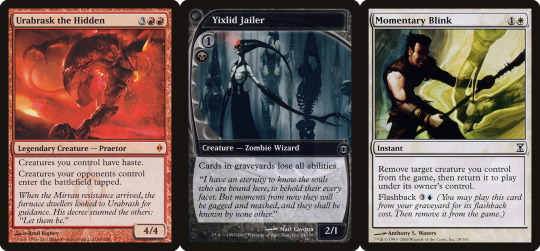
Urabrask’s ability only works while he’s on the battlefield, and only creatures you control on the battlefield would get haste - after all, those are the only ones who can use it, anyways. Yixlid Jailer takes away abilities from cards in graveyards, so Momentary Blink would not have Flashback while it’s there. Momentary Blink also exiles a creature (using the old wording of “removed from the game”) and brings it back, known as flickering.

Private zones are anywhere where cards are not public information. This includes your hand and your library. Thoughtseize, and other similar hand disruption spells, let you take a peek at what your opponent has. Loads of cards like Armillary Sphere let you search your library for cards. Others may reveal the top card of your library, or let you look at the top few.
It’s also possible to have “hidden” cards in public zones. Willbender feature the Morph mechanic, which lets you cast it face-down as a 2/2 creature. This means your opponent won’t know what it is until you turn it face up, but you will. Other effects might put cards face-down in exile, where you could cast them.
Whenever a card changes zones, it becomes a new “object”. That means all counters, equipment, and auras fall off, and it is no longer being targeted by anything that was targeting it before. A classic use of this rule is flickering a creature being targeted by a kill spell - even though it comes back to the battlefield, it is a new object and is thus no longer being targeted by the kill spell. The spell will fizzle and your creature will be safe.
7. Starting the Game
Ok. So you’ve got a basic understanding of all the cards and the different locations. How do you get started actually playing?
There are lots of ways to play the game, but I’ll start out with the most common: a 1v1, best of 3 duel. This will also get a little bit into deckbuilding, but there’s a lot more on that later.
Most 1v1 decks will be 60 cards. In fact, this is a lower limit, and you can have as many cards as you want, but it’s convention to stay at 60 cards to maintain consistency. In a best of 3 match, you will also have a sideboard - 15 or less cards that may target specific strategies such as graveyard decks or artifact decks. After your first game and seeing what your opponent is playing, you’ll be able to switch out cards in your deck for the right silver bullets for games 2 and 3.

Common sideboard cards against Burn, graveyard, and artifact strategies.
If you’re playing a casual game with a friend, feel free to omit the sideboard, but it’s a staple part of competitive play and is a fun way to personalize decks in strictly defined metagames.
Now that you’ve got a deck (and presumably, a friend with a deck as well) shuffle up. Cut your opponent’s deck by putting the top half on the bottom (a customary ritual to prevent cheating) and let them cut yours. Figure out who’s going first by rolling some dice (whoever wins gets to choose, but generally going first is preferred), and draw seven cards.
You may not like your hand for several reasons. Maybe you have too many lands, or none at all. Your lands might all produce the same color of mana instead of all the colors you need, or you might have only highly-costed spells and nothing to do on your early turns.
No problem, just shuffle it back in and draw seven more. This is called mulliganing. You can do this as many times as you want, but don’t be too hasty, because once you find a hand you like, you’ll need to put one card from your hand on the bottom of your library for each time you mulliganed.
Now it’s time for your first turn. But before we really get playing, let’s look at the structure of a turn.
8. Phases of a Turn

credit to u/paper_alien
From this fancy diagram, we can see that your turn is broken down into roughly three different parts. I’ll be including examples of cards that interact with each phase. First is the beginning phase.
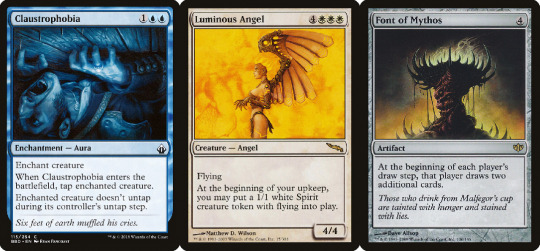
Your untap step is right at the start, when all your permanents untap. Simply turn them right-side up. Claustrophobia would prevent one of your opponents’ creatures from untapping, rendering it useless as an attacker and blocker, as well as preventing its tap abilities from being used. No player gains priority during the untap step, and play immediately proceeds to the upkeep step.
Normally, nothing happens here, unless an ability triggers. For example, the Luminous Angel gives you a 1/1 token on your upkeep. Players will get priority, so you’ll have a chance to cast instants or activate abilities as well.
After that is the draw step. You immediately draw a card, and abilities like that of Font of Mythos will trigger. Again, priority passes around. Once you’ve finished with the draw step, move on to your main phase.
Side note: Normally, players will typically condense these three steps into one (untapping and drawing), because it’s rare that you do play something here, but the steps are distinct for those cases in which you do need to take an action.

As mentioned above, your main phases are the only times you can play lands and non-instant spells, as well as activate planeswalker abilities. They sandwich your combat phase. It’s uncommon for cards to trigger during your main phases, but the two above are prime examples of such cards. Many activated abilities will also have an explicitly written restriction to only use them during your main phases.

The combat phase is the most complex, as it is really made up of five to six distinct subphases. First, you declare that you are going to move to combat. This will trigger cards like Hazoret’s Favor, and will give your opponents an opportunity to subdue your creatures before they can attack but after you have a chance to cast relevant non-instant cards.
Once priority is passed around, you move to the Declare Attackers step. Here, you will tap each creature you want to have attack, meaning you can only attack with untapped creatures, and declare the player or planeswalker it will be attacking. Creatures do not attack other creatures (this isn’t Hearthstone), and instead your opponent will have a chance to block your creatures with their own.
This happens after priority is passed around and you move to the Declare Blockers step. Your opponent will choose which of their untapped creatures they want to block your attacking creatures. Each creature can block up to one other creature, but any number of creatures can block one creature.
Next is the Damage step. Here, each unblocked creature will deal damage to the player or planeswalker it’s attacking, and each blocked or blocking creature will deal damage equal to its power to the creature(s) it’s been pitted against. If one of your creatures is being blocked by multiple, you need to divide its power among them. For example, a 3/3 being blocked by two 2/1′s must deal 1 damage to one and 2 damage to another. All creatures who have been dealt more damage than their toughness die and are put into the graveyard.
The theoretical sixth step actually occurs before the Damage step - the First/Double Strike step. If any creatures with first strike or double strike are involved in the combat, this step will be created and those creatures will have an opportunity to deal damage before other creatures. For example, if a 5/1 with first strike is blocked by a 3/3, the 5/1 will deal 5 damage to the 3/3 before it has a chance to fight back, and the 3/3 dies. Double strike means the creature deals its damage twice - during this phase and the regular combat phase.
Finally is the End of Combat step. Similarly to the Beginning of Combat step, this is mostly a formality, but some cards do trigger here (such as the Wall of Cinders), and priority is passed around.
Notice that you also get priority after every one of these phases, meaning you have tons of control over what happens. This allows you to play combat tricks. For example, say you attack with a 4/4 and your opponent has a 4/2. They might think you just want to trade creatures (meaning both die) and blocks your attacker. Before damage, you have a chance to play Giant Growth, pumping your creature out of range of your opponent’s creature, so yours survives.

This is also a great time to cover the keyword abilities I’ve been bringing up throughout, as many of them concern combat. Many of them are fairly self-explanatory, and are not exclusive to creatures.
Deathtouch: Whenever this creature deals damage to another creature, that creature dies.
Defender: This creature can’t attack. Often seen on Walls.
First Strike/Double Strike: As mentioned above, these let the creature deal damage before other creatures. Double Strike means it deals damage twice, once in the first strike damage phase and once in the regular phase.
Flash: You can play this card at instant speed. Can appear on any permanent card.
Flying: This creature can’t be blocked except by other fliers and creatures with Reach.
Haste: This creature isn’t affected by summoning sickness.
Hexproof: This can’t be targeted by your opponents’ spells and abilities. This doesn’t prevent it from being affected by “choose” or “all” effects.
Indestructible: This can’t be destroyed by damage or effects that say “destroy”. It can still be sacrificed, exiled, or given -X/-X to reduce its toughness to 0.
Lifelink: Whenever this deals damage, you gain that much life.
Reach: Can block creatures with flying.
Shroud: Like Hexproof, but also prevents you from targeting it (for example, with a pump spell or equipment).
Trample: Excess combat damage can be dealt to your opponent. However, you still need to deal lethal damage to any blockers. For example, a 5/5 with trample being blocked by a 2/3 must deal at least 3 damage to the 2/3 so that you can deal 2 damage to your opponent.
Vigilance: This creature doesn’t need to tap when attacking.
Menace: This creature must be blocked by at least two creatures.
There are many, many more keyword abilities, but these are the most common - the rest you will come across as you explore the different sets and planes.

After your second main phase comes the end step. In reality, you’ll care more about your opponent’s end step, because it is the optimal time to play removal, card draw, or other useful instants because it will give your opponent the least amount of time to react before your next turn. However, once priority is passed during your end step, check if you have more than seven cards in your hand - the maximum hand size. if you do, the cleanup step is created. Here, you must discard down to seven cards, and there will be another chance for priority after that. Seven is the default maximum hand size, but there are many cards that let you play around with that.
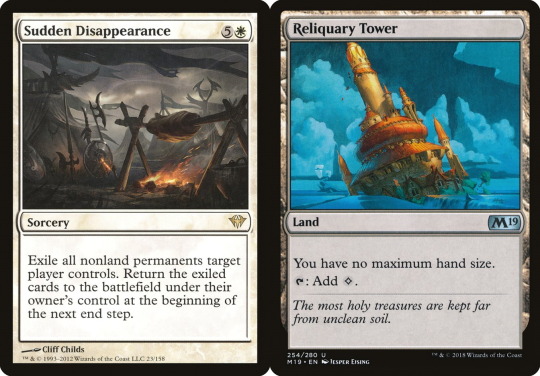
So now you’ve got your deck, you’ve mulliganed as you need, you’ve played an Island. I see you preparing to cast that Opt - but wait! Casting a spell is quite a bit more complex than it first seems, so let’s go over that now.
9. Casting Spells and Activating Abilities
All this time, I’ve been talking about casting and activating without really explaining exactly what that means, so now let’s make sure you know what that means. There is a lot of nuance to properly casting a spell, but once you understand it, you can ignore all the decorum in most cases. However, it’s still important to know exactly what happens to prevent common misunderstandings, and because Magic is full of strange cards that love to bend the rules; you will doubtless find fun corner cases.
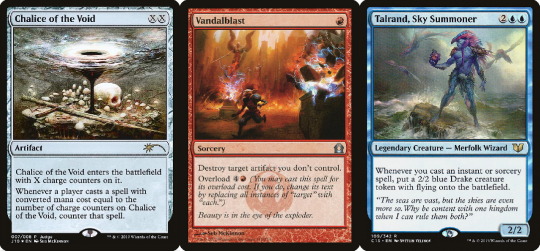

The steps to casting a spell and activating an ability are identical except the first, so I will be going over them together, referring to casting a spell.
Declare you are going to be casting the spell by putting it from where it is (generally, your hand) onto the stack. An ability will be put onto the stack as an arbitrary object.
Declare all the additional and alternative costs you wish to pay (for example, Vandalblast’s Overload cost), the mode of the card for split cards (such as Assure // Assemble) and double-faced cards (such as Alrund, who is also a bird on his other side!), and define the value of X (such as for Chalice of the Void), which you can pay for in mana of any color.
Choose the targets of your spell. You must have a legal target for each time the word “target” appears on the card (this is when effects such as “When this becomes the target of a spell” are triggered and go on the stack, to be sorted out and resolved later).
Now determine how much you need to pay. This includes cost reductions and additional costs, such as for Torgaar, as well as taxing effects (i.e., “noncreature spells cost {1} more to cast).
Activate mana abilities, such as those from your lands and mana rocks, and pay all costs as required. This means, for example, that you can tap a creature that produces mana and sacrifice it to pay for Torgaar.
Congratulations! Your spell or ability is now on the stack. Abilities that trigger while you are casting your spell, such as Talrand’s, will be on the stack above it and will thus resolve first. We covered fizzling before, but to clarify, a spell will fizzle only if all its targets are no longer legal, either through dying, or gaining Hexproof, or some other means. This means you get no part of its effects. If it has multiple targets, and only some become illegal, the card resolves as normal.
Like I said, you really don’t need to understand all of this in depth, but it helps clarify the occasional odd rules interaction.
10. Abilities
There are four types of abilities that you might find on cards. The one we’ve just covered extensively was activated abilities, which further come in two forms.
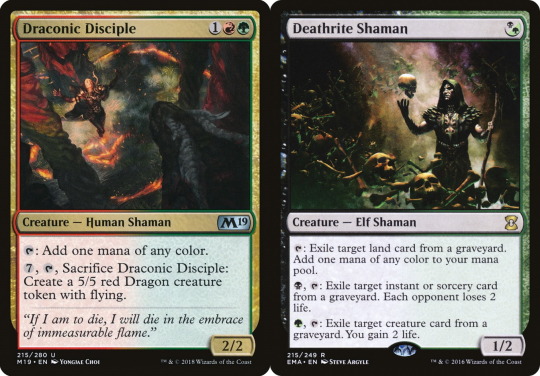
Draconic Disciple handily features both: a mana ability, and a normal activated ability. Notice that all activated abilities use the syntax “Cost X, Cost Y: Ability.” As we covered last chapter, you need to use mana abilities before paying costs when activating an ability, so you couldn’t tap Draconic Shaman for mana for his own ability as well as tap him to summon the dragon.
The main distinction for mana abilities is that they don’t use the stack, resolve instantly, and can be used while casting spells. An activated ability is considered a mana ability if and only if all it does is create mana. That means that Deathrite Shaman’s first ability is not a mana ability, because it exiles a land in addition to creating a mana.
The three other types of abilities are triggered abilities, passive abilities, and replacement effects.

Vanquisher’s Banner features a passive ability by giving all your creatures of a certain creature type +1/+1. It’s pretty straightforward: a static ability simply applies as long as the permanent which has it is on the battlefield. There are nuances in “layering”, but this is already far more complex than you’ll need to know for the majority of games. Feel free to read that article, though.
Vanquisher’s Banner’s third ability is a triggered ability - an ability that goes on the stack when something happens. This could be casting a spell, a creature entering the battlefield, or drawing a card - or just about anything. These are generally in the form “When” or “Whenever”, and should not be confused with replacement effects.
Replacement effects, like the one seen on Teferi’s Ageless Insight, come in the form “If... would... instead”. They are similar to triggered abilities in that they occur in response to something happening, but they don’t use the stack. Instead, think of them as modifiers to abilities. For example, if Teferi’s Ageless Insight was formatted like a triggered ability, drawing you a card each time you drew a card, you’d be stuck in an endless loop of drawing. Instead, replacement effects only apply once to each thing they modify.

There are many ways that abilities might manifest themselves, and they don’t always need to be on the battlefield. Bridge From Below’s wall of text works when it’s in the graveyard. Skyscribing’s ability only works from your hand, and is keyworded by Forecast, which only appeared in the original Ravnica set.
The best way to experience all the different interesting abilities and cards is just by playing and expanding your collection. Enjoy playing around and learning more about the game.
This is just about all you need to know to understand the game itself. However, Magic cards just love bending the rules, so you’ll always be encountering interesting rules interactions that will teach you more about the game as you play.
11. Formats
Here is where the fun really begins. Choosing a format is like choosing a social media platform: it comes with its own drama, flavor, speed, and player personalities. All formats use 60 card decks with 15 card sideboards, and start at 20 life, except Brawl and Commander. Each format has its own banlist, so make sure you check that before building just any deck. However, feel free to totally disregard all formats and just build whatever deck you want to have fun with friends!
Here are the most popular formats:
Standard: Probably the most popular 1v1 format, Standard uses cards from the last few sets, and constantly rotates. Deck prices can range from under 100$ to over 500$ when certain powerful cards are in rotation, but when a card rotates out, it can lose its value if it isn’t played in older formats. It can be competitive, but also lets you play with fun new cards in a weaker environment.
Pioneer: The newest official format, Pioneer uses cards dating back to the set Return to Ravnica. It has the same fresh feel as Standard, but doesn’t rotate and is closer in power level to Modern.
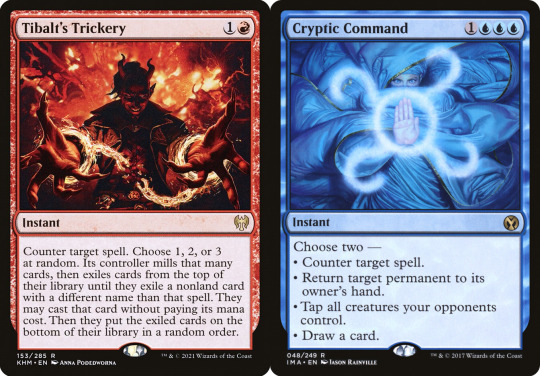
Modern: This format uses cards from the newest set all the way back to Eighth Edition from 2003. Decidedly more powerful than Standard, and expensive as well. Competitive decks can range from 200-1000$, but the vast size of the card pool means you can find budget builds and underdog decks to tinker with.
Legacy: You can use any card in the history of Magic, except those from the Banlist. The power level is incredibly high, yet the stereotype of 2-turn games is not as true as one might think. Because of the original dual lands, decks are often over 1000$, but mono-colored decks such as Burn can be brought down to 200$. Definitely not for the faint of heart.

Vintage: Like legacy, all cards are at your disposal, and this time, instead of a banlist, you have a restricted list, meaning you are limited to 1 copy of certain cards. A single copy of Black Lotus can be tens of thousands of dollars, and is a staple alongside the rest of the Power Nine. Very few play it because of the price tag, but it lets you tap into the true power of the oldest Magic cards.
Commander (AKA EDH): Play with any card, like Legacy, but with the distinct Commander banlist. The deckbuilding process here is very different: Pick a legendary creature you like, and pick 99 more cards that are of the same color(s) as your commander. This is a singleton format, meaning you can only have one of each card except for basic lands. Commander is also a multiplayer format, played in pods of 3-6; most often 4. Your commander starts in the Command Zone, where you can cast it. Each time it dies, it goes back to the Command Zone, where you can replay it for an additional 2 mana each time. The multiplayer nature, 40 starting life total, and high variance make Commander incredibly casual, much more a social event than a game. Have fun casting huge spells, playing pet cards, and embodying your commander. That being said, there’s a competitive scene in EDH, known as cEDH.
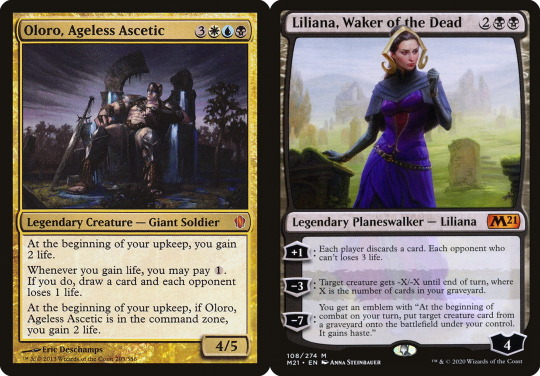
Brawl: Ah, Brawl. Commander’s younger, forgotten brother. It’s a cross between Commander and Standard, in which you have a commander (in this case, it can also be a planeswalker) and must have singleton copies of cards. Like Standard, you can only use cards from the last few sets, your deck is only 60 cards (no sideboard, though), and games are 1v1. You start with 25 life. Almost nobody plays this in person, but it’s very fun on MTG Arena.
12. Where to Play
Assuming you don’t have a group of friends ready to accept you into their playgroup, finding people to play with can be hard. First, I’d recommend checking Wizards of the Coast’s official Store Locator to find local game stores that might be hosting events and selling cards. If you go to their websites, they’ll often have calendars listing events by date, format, price, and prize. Explore and find one you like. MTG players are generally friendly, and will be willing to accept you into their playgroup, teach you about the game, and maybe even let you borrow a deck!
If you don’t feel like playing in person, there are several online options.
Magic Online (AKA MTGO or MODO) is the primary official way to play. Pay 10$ for an account, and you can buy, sell, and trade cards as if they were real. No really - Magic cards are almost like stocks, and MTGO cards are basically digital versions of Magic cards, so their price will generally mirror their real world counterparts, albeit at a lower price.
Magic Arena (MTGA) is the newest official online game. It only has cards from recent sets, back to Kaladesh, as well as a few odd cards hand-picked for Historic play (a format specific to the game that uses all cards available). Because of the smaller card pool, MTGA is limited to Standard, Brawl, and Historic as the primary game modes. However, it is free to play and your collection can’t be traded, so you collect cards somewhat like Hearthstone.
There are also a few unofficial programs, including Untap.in, XMage, and Cockatrice, which are free and give you access to the full range of cards for testing new decks before you buy them in paper.
Make sure you keep track of MagicFests, official conventions hosted both around the world and online, to meet tons of new people and play in competitive events.
Ultimately, though, many people choose to play at home around the kitchen table with friends and family. Play wherever and however you feel most comfortable; after all, Magic’s best aspect is self-expression.
13. Accessories

Credit: Tolarian Community College
If you’ve visited a local game store by now, you may have noticed that they sell way more than just cards. There are a myriad of accessories you can use to personalize your game and protect your cards.
Dice: from D4′s to D20′s, you can find these in countless colors and styles. Have fun picking your favorite and use them to keep track of life totals, counters, tokens, and more.
Sleeves: These can come in many different colors and designs, but vary wildly in quality. Pick the ones that feel right for you. These will help you shuffle your deck with ease and prevent your cards from getting damaged. Inner and outer sleeves provide additional protection for your most valuable and prized decks.
Deckboxes: Again, tons of variation. The right deckbox for you will depend on how many cards you want to fit in it, if you want space for dice, the design, and much more.
Playmats: These provide a sleek surface for you to easily pick up, tap, and move your cards around. Pick ones with your favorite Magic art, or order one with your own.
Trade Binders: Once you’ve built up a collection, you might have a few valuable cards you want to show off. Put them in a trade binder, and approach people to find other neat cards you might need.
Tolarian Community College on Youtube provides the best reviews of popular accessories, rating and testing them thoroughly. He also dishes out incredible commentary on new sets and the state of the game. Probably the most popular MTG Youtuber out there.
14. Further Resources
You’ve made it this far, but there’s still so much to explore! Here, I’ll be listing plenty of websites that are excellent resources to expand your understanding of the game.
The official rules: Quite dry, but this is where to go if you ever find a confusing interaction.
Tolarian Community College: I just discussed him, but I must reiterate how awesome his channel is.
Scryfall: A powerful search engine for all the Magic cards you might be looking for. What I’ve been using for card images this whole time. WOTC’s official Gatherer pales in comparison.
TCGPlayer: My favorite way to order cards online, but alternatives include Card Kingdom, StarCityGames, and ChannelFireball.
MTGGoldfish: An excellent all-round resource for keeping track of metagames, card prices, and interesting articles and gameplay. You can also use it to find, build, and share decks and see their prices.
EDHREC: This site conglomerates EDH decks from around the internet to give you a condensed list of the best cards by commander. A must-have resource when building new commander decks.
Last but not least, the best way to learn to play Magic is to watch others. I started out by watching gameplay from Grand Prix’s and other competitions on Youtube. Even though I barely knew what the cards were, I quickly picked up the most popular ones, learned common play patterns, and more. You don’t need to be a pro to learn from them.
15. Have Fun!
Yeah, it’s cheesy, but as I’ve reiterated, Magic is a game of self-expression. With thousands of cards to pick from, plenty of formats, styles, and accessories, customize your play experience as much as you want and be comfortable with that. Meet new people, participate in trading, and play in local events. Magic is what you make of it, so make it the best it can be.
30 notes
·
View notes